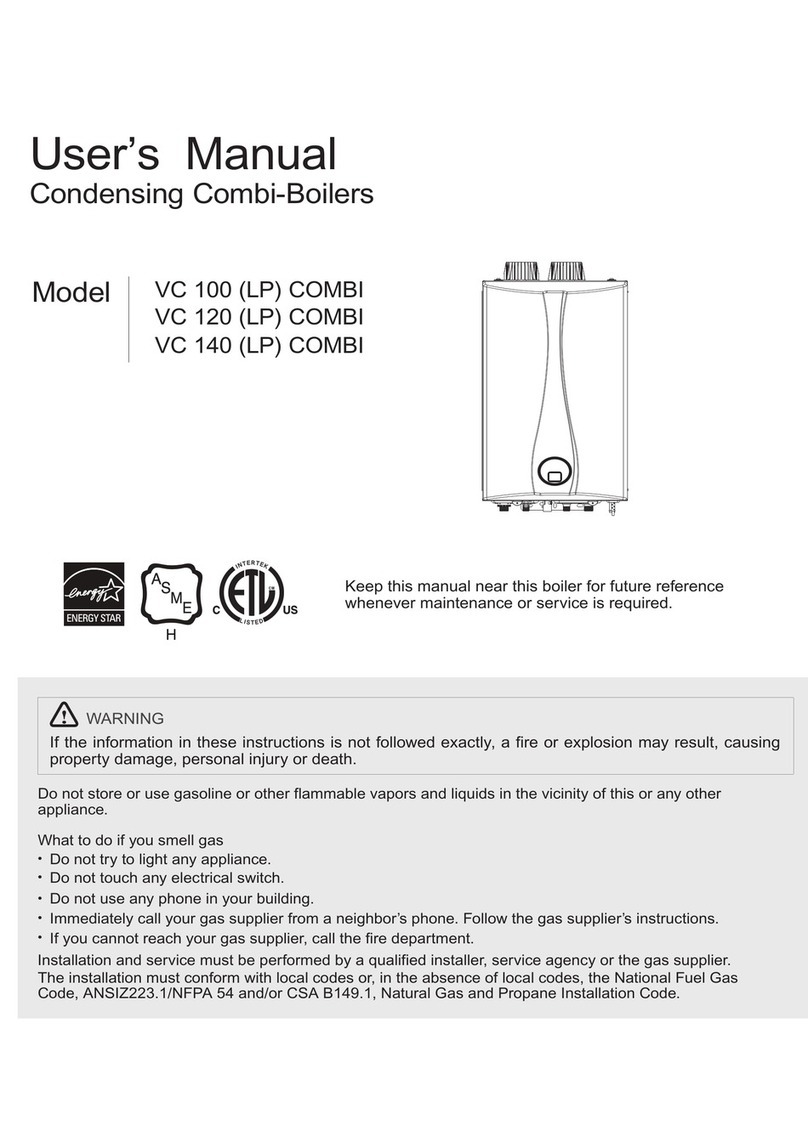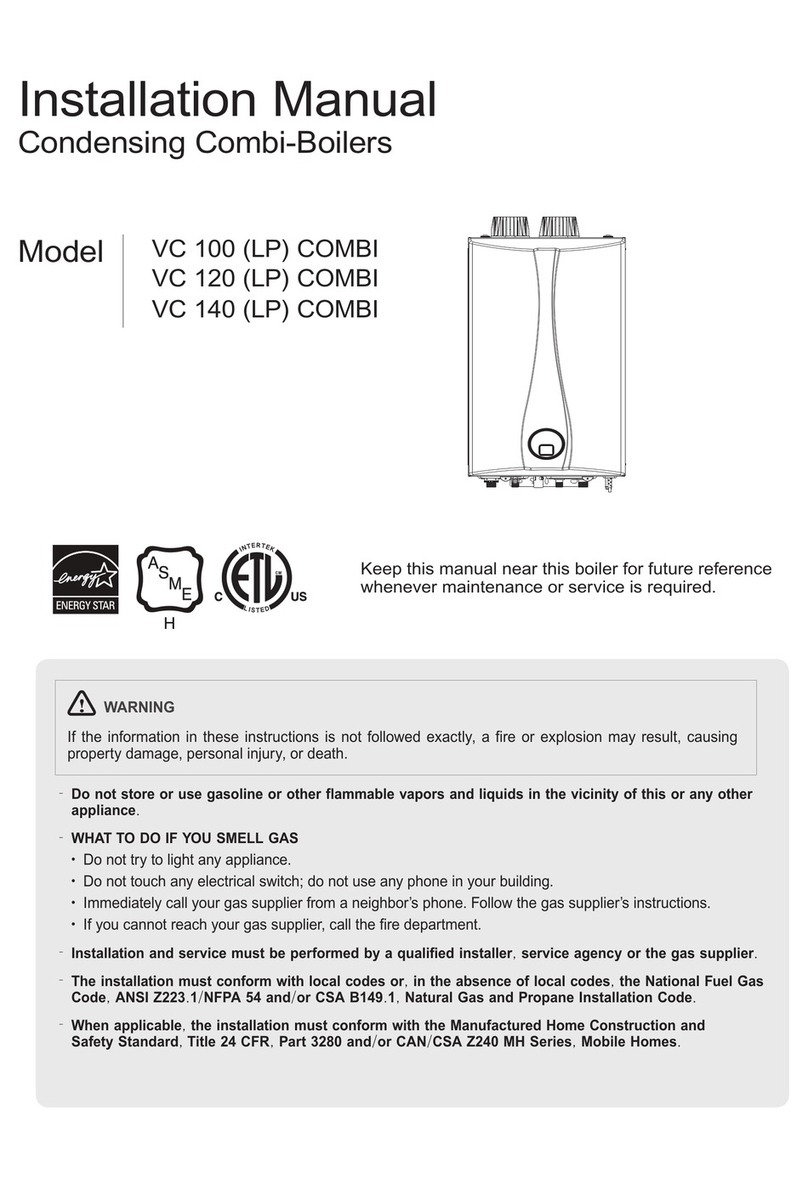3 4
Connecting the Condensate Drain
External drain
Direct to
an external drain
To a drain via
a neutralizer
To a laundry tub
To a laundry tub via
a condensate pump
(a) From the boiler directly into an external drain.
(b) From the boiler , through a neutralizing agent, and then into an external drain.
(c) From the boiler into a condensate pump, and then into a laundry tub.
(d) From the boiler into a laundry tub.
Condensate Trap
Before operating the boiler , fill the condensate trap with water through the flue
connector. The boiler may be severely damaged unless filled with water prior to
operation. Pour 0.1 gallon (400 ml) of water into the exhaust duct. Deflate air sufficiently
or equip the air vent with an outlet pipe prior to filling the condensate trap with water
(there must be no air inside the heat exchanger).
Installing a Vent
Vent Lengt
Vent Size Maximum
Length
Maximum #
of Elbows Equivalent Lengths
2" 60' (18 m) 6
Reduce the maximum vent length
accordingly for each elbow used:
•Each 90° elbow equates to 8 linear
feet (2.4 m) of vent
•Each 45° elbow equates to 4 linear
feet (1.2 m) of vent
3" 150' (45 m) 8
Reduce the maximum vent length
accordingly for each elbow used:
•Each 90° elbow equates to 5 linear
feet (1.5 m) of vent
•Each 45° elbow equates to 3 linear
feet (0.9 m) of vent
Connecting the Vent Clip
Caution
To connect the exhaust vent firmly, must use the vent clip included with boiler .
To connect the vent clip:
1Connect the vent clip to the exhaust vent.
2Connect the exhaust vent and the vent clip to the flue connector.
Notice
Tighten the screws and fix the vent clip.
Two-pipe sidewall venting
Internal view
Intake air
Exhaust gas
10" min.
External view
12" (300 mm) min.
Intake air Less than 45°
Exhaust Gas
12" (300 mm) min.
Caution
•Maintain 12" (300 mm) min. (18" (450 mm) min. for Canada) clearance above
highest-anticipated snow level. Maximum of 24" (600 mm) above roof.
•Install a bird screen at the end of the intake air pipe and exhaust pipe.
Notice
It is recommended to install the intake air vent terminal as far from the exhaust gas vent
terminal as possible.
Non-concentric sidewall venting
12" (300 mm) min.
10" (254 mm) min.
Caution
•Maintain 12" (300 mm) min. (18" (450 mm) min. for Canada) clearance above
highest-anticipated snow level. Maximum of 24" (600 mm) above roof.
•Install a bird screen at the end of the intake air pipe and exhaust pipe.
Notice
Air is drawn from a different location at a minimum of 12" (300mm) from the exhaust
termination. Try to minimize the length of the intake air pipe with this venting.
Concentric sidewall venting
Combustion air
Vent
Combustion air
Maintain 12"
(300 mm) min.
Vent
1" (25 mm) min.
Caution
Maintain 12" (300 mm) min. (18" (450 mm) min. for Canada) clearance above
highest-anticipated snow level. Maximum of 24" (600 mm) above roof.
Connecting the Power Supply
Warning
Improperly connecting the power supply can result in electrical shock and
electrocution. Follow all applicable electrical codes of the local authority having
jurisdiction. In the absence of such requirements, follow the latest edition of the
National Electrical Code (NFPA 70) in the USA or the latest edition of CSA C22.1
Canadian Electrical Code Part 1 in Canada. Connecting the power supply should
be performed only by a licensed professional.
When connecting the power supply, follow these guidelines:
•Do not connect the electric supply until all plumbing and gas piping is complete and
the boiler has been filled with water.
•Do not connect the boiler to a 220-240V AC power supply. Doing so will damage the
boiler and void the warranty.
•All boiler s come with a factory-installed, 3-pronged (grounded) plug.The boiler can
be plugged into any grounded electrical outlet nearby, as it requires only 2-4 Amps.
It is not necessary to run a dedicated electrical line to the boiler .
•If local codes require the boiler to be wired directly, remove and discard the factory-
installed plug. Install a power switch between the breaker and the boiler to facilitate
end-user maintenance and servicing. Connect the boiler to a 110-120V AC at 60 Hz
with a maximum of 5A rating electrical supply.
•The boiler must be electrically grounded. If using the power plug, ensure that the
electrical outlet you connect the boiler to is properly grounded. If wiring the boiler
directly to a power supply, do not attach the ground wire to either the gas or the
water piping as plastic pipe or dielectric unions may prevent proper grounding.
•We recommend using a surge protector to protect the boiler from power surges.
•If there is a power failure in cold weather areas, the freeze prevention system in the
boiler will not operate and may result in freezing of the heat exchanger. In cold
weather areas where power failures are common, you must completely drain the
boiler to prevent damage if the power is expected to be off for any extended period
of time. A battery back-up (available at most computer retailers) may be used to
supply hot water during periods of power outages. Damage caused by freezing is
not covered under warranty.
Setting the Long Flue
Set the DIP switch appropriately, depending on the installation environment.
Switch Function
Long flue Length 1
DIP
S/W
#3
DIP
S/W
#4
FLUE LENGTH
2”
PVC
3”
PVC
OFF OFF Up to
15’
Up to
150’
OFF ON Up to
30’
N/AON OFF Up to
45’
ON ON Up to
60’
Long flue Length 2
Operating the Boiler
Turning the Boiler On or Off
To turn the boiler on or off, press the button.
When the boiler is on, the water temperature which has been set recently will appear
on the digital display.
Setting the Space Heating Temperature.
Danger
If your household includes children, or elderly or disabled individuals, consider
using a lower temperature setting.
To set the space heating water temperature.
1Press the MODE button until the icon turns on.
2Press the or buttons until the desired temperature appears on the digital
display.
Setting the DHW Temperature
Caution
Water above 120°F (50°C) can cause instant scalding, severe burns, or death.
To adjust the water temperature:
1Press the Mode button until the icon turns on.
2Press the or buttons until the desired temperature appears on the display.























